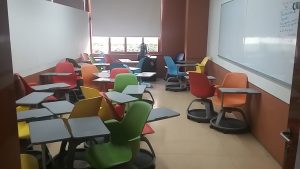So the last two days I was pretty well bedridden all day with the flu so I was not very capable of helping my colleagues out at school. Luckily, the girl’s Catholic school was not in session on Thursday (apparently for Cinco de Mayo), so my colleagues went back to Technologico de Monterrey to try and help with anything they could help with, while I rested up. On Friday, I went to the girl’s Catholic school in the morning, but by recommendation of our coordinator, I was examined by the school physician and after receiving some medication, they suggested I go home and rest for the rest of the day.
Even though I could not actively participate in teaching it was recommended that I compare and contrast the two schools that we have helped at. So this is what my blog today will be about.
Technologico de Monterrey:
This school is in the top three of all private schools in all of Mexico. With multiple campuses across Mexico (three in Mexico City area) they have three different programs, their most well known is their IB program. These students are usually among the more wealthy of Mexican people (as one teacher puts it, “they are either rich children or Military children…”). Technologico de Monterrey is not only isolated to high school, they also have THE most prestigious business entrepreneurship school in all of Latin America. Students in the high school have the choice of studying abroad, going to the business school, or going to other post secondary institutions upon graduation (depending on the program they chose to enroll into in high school). Technologico de Monterrey offers a wide variety of extracurricular activities including, Soccer (of course), American Football, Volleyball, Basketball, and Cheer and Dance. They also offer some of these activities to their feeder schools to groom them for when they come to Technologico de Monterrey.
Being such a prestigious school, there is an extremely high security system in place. Aside from thick steel barred fences and gates, there were armed guards and security cameras at all the entrances. One could not enter without a valid Technologico de Monterrey student ID, Staff ID, or if you’re a guest you need to have notified the school in advance so that someone of authority could add your name to a list for the security team. Taxis and Uber cabs were allowed to go into the campus to pick up and drop off people, but they had to fill out a slip with there they were coming from and where they were going afterwards as well as leaving a piece of ID with the security team until they left the premises.
In the classroom, the set up is either the individual coloured chairs (that was mentioned in one of my previous blog posts), or the long tables that are able to seat 3-4 people. Teachers have the autonomy to choose whether to teach their class in English or in Spanish, and many of them have other jobs (teaching 1-2 blocks is just a hobby, passion, or a way to make a little bit of extra cash). One example is a sustainability teacher who works for Coca Cola Mexico as a sustainability expert.
Instituto Mexicano Regina:
Similar to Technologico de Monterrey, Instituto Mexicano Regina is also a private school with multiple campuses across Mexico. The campus that we were at was the original one that was started by nuns (from Spain I think), This campus has around 80 years of history (to put this into perspective, one of the teachers who is 40 had a great grandmother who attended the school as a girl). This campus has stayed true to the original intent of being an all-girls school (some of the newer campuses are co-ed). This school is very exclusive, it is not necessarily the rich girls that can get in, but the best chance to be accepted is if you had a mother or grandmother who attended the school previously. Unlike Technologico de Monterrey, they have programs running from Pre-K – 12 and they have no extra curricular activities offered (although many of them are in programs outside of school, such as dance). One thing that we noticed almost immediately was the whole difference in atmosphere. The girls were very curious having visitors around (this could tie in with the fact that it is an all-girls school maybe?). Also, it seemed like more students were willing to and were capable of speaking proficient English (at Technologico de Monterrey, we had to approach students and ask if they spoke English). Teachers noticed that while we were around, students would come and ask them something in English, when they usually ask it in Spanish. The girls at this school are divided into three classes based on their English capabilities, but all girls take the same courses (it’s just the level of English being taught to them that is different). Supposedly, by the time they graduate, these girls will have the credentials to teach English (which seems to be their big focus).
The security is also very tight at this school. Even though there are no armed guards, students are all driven to school by buses. Every bus that enters the campus gets checked off by someone who works at the school to ensure that all the buses have been accounted for. Each bus has a driver and a “bus mother”, both are exactly the same day in and day out on their specific bus route. Once on campus, students enter through open gates (which are immediately closed when all the buses have been accounted for). During this whole process, the nuns and other school staff patrol the gates to make sure that no one goes into the school who didn’t come off one of the buses. Once everyone is safely inside and the gates closed, the only way in is through a barred gate that needs to be buzzed open. Once past that one needs to sign in with the secretary and then buzzed in through another door only when a school representative is available to take you in.
Classrooms at this school are set up in the old-fashioned way of individual chairs and desks. As mentioned in a previous blog post, students stay in their class unless they have a subject that requires a different facility. Teachers here also have autonomy over what language they choose to teach with, however, with the whole English credentials they strive for, students are strongly encouraged to use English on a day to day basis. Teachers here do not get paid a large amount, they literally get paid equivalent to $10 CAD an hour. Many of these teachers are not here for the money, but more for the passion of teaching. Some of these teachers have alternative incomes (either from another job, or a spouse).
During our stay, we did not get a chance to observe in a public school setting. However, we can see how different schools are just within the private sector. The little I have heard about public schools in Mexico is pretty horrendous. Class sizes ranging from 35-50 students and no EAs to help with IEPs or anything. During my 10 week practicum, my classes ranged from 20-28 students, and the highest number doesn’t even hit the bottom border of public schools here. That is a scary thought, because some days it took all I had just to maintain control in my classes during my 10 week practicum, I can’t imagine dealing with 35-50 students on a regular basis for the rest of my career.








